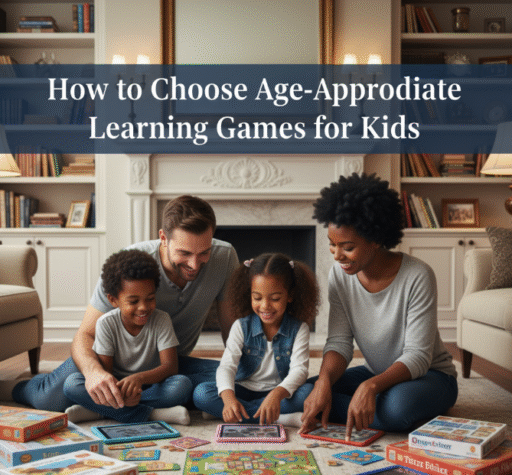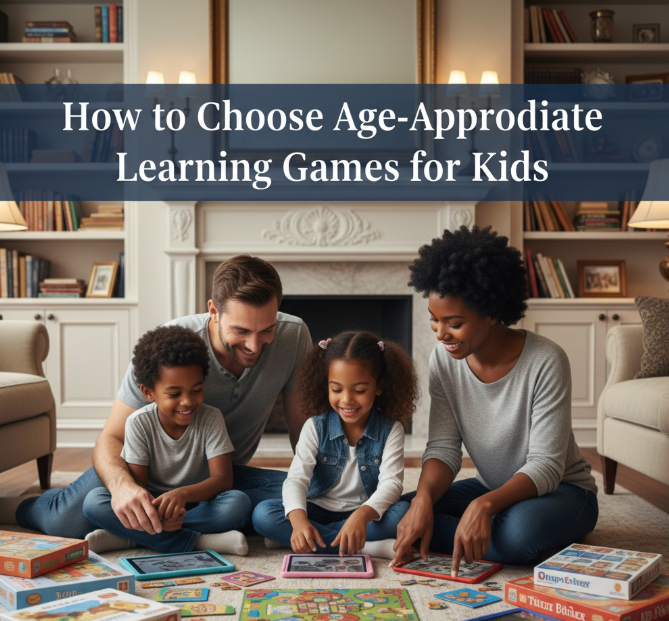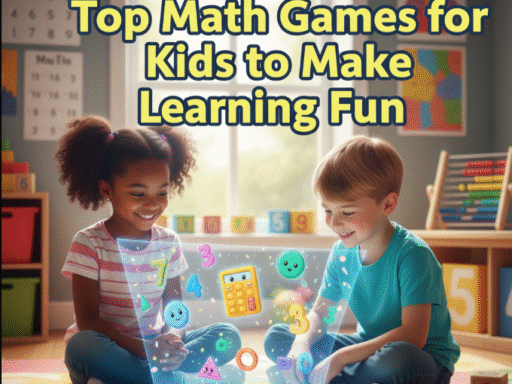Introduction
Every parent wants their child to learn and grow while having fun. One of the best ways to achieve this balance is through learning games for kids. These games combine play with education, helping children develop essential skills without feeling pressured. But here’s the challenge—not all games are right for every age group. A game that works perfectly for a 5-year-old might confuse or bore a 10-year-old. That’s why choosing age-appropriate learning games is so important.
In this guide, we’ll explore how to select the right games for children of different ages. You’ll discover what skills each age group needs, the best types of games for them, and practical tips to make smart choices. By the end, you’ll be ready to confidently pick games that make learning both fun and effective.
Why Picking the Right Game Matters
Games are more than entertainment—they shape how kids think, solve problems, and interact with the world. Choosing the right one makes a big difference.
Benefits of Age-Appropriate Games:
-
Boosts brain development – Games designed for a child’s age target specific learning milestones.
-
Encourages creativity – Younger kids explore imagination, while older ones learn strategy.
-
Improves focus – The right challenge keeps kids engaged instead of frustrated.
-
Strengthens social skills – Multiplayer or cooperative games teach teamwork.
-
Supports school learning – Games can reinforce math, reading, science, and problem-solving skills.
On the flip side, picking the wrong game can cause frustration, boredom, or even loss of interest in learning.
Key Factors to Consider When Choosing Learning Games
When selecting a game for your child, consider more than just age labels. Look deeper into what the game offers.
1. Developmental Stage
Children grow through different learning stages:
-
Toddlers (2–3 years): Focus on colors, shapes, sounds, and basic motor skills.
-
Preschoolers (4–5 years): Learn letters, simple counting, and memory games.
-
Early Elementary (6–8 years): Start reading, problem-solving, and logical thinking.
-
Tweens (9–12 years): Explore advanced reasoning, strategy, and creative projects.
2. Learning Goals
Ask yourself: What skill should my child develop?
-
Literacy (letters, phonics, vocabulary)
-
Math (counting, addition, multiplication)
-
Science (nature, experiments, cause and effect)
-
Creativity (drawing, storytelling, music)
-
Social skills (teamwork, sharing, communication)
3. Engagement Level
A game must balance fun and challenge. Too easy? Kids get bored. Too hard? They get frustrated. The sweet spot lies in games that keep them curious and motivated.
4. Safety and Screen Time
If it’s a digital game:
-
Check if it’s ad-free.
-
Look for parental controls.
-
Ensure it limits unnecessary screen time.
For physical games:
-
Ensure pieces are safe and non-toxic.
-
Avoid choking hazards for toddlers.
5. Longevity
Choose games that grow with your child. For example, puzzles with increasing difficulty levels or apps that unlock new challenges over time.
Learning Games by Age Group
To make things simple, let’s break it down by age.
1. Games for Toddlers (Ages 2–3)
At this stage, kids are curious explorers. Games should be colorful, interactive, and hands-on.
Best game types:
-
Shape sorters
-
Color-matching puzzles
-
Animal sound games
-
Simple musical instruments
Examples:
-
Wooden shape puzzles
-
Peek-a-boo apps
-
Building blocks
Skills developed:
-
Hand-eye coordination
-
Recognition of shapes and colors
-
Cause-and-effect understanding
2. Games for Preschoolers (Ages 4–5)
Preschoolers start building early academic skills. Games should introduce letters, numbers, and memory challenges in a playful way.
Best game types:
-
Alphabet matching
-
Counting games
-
Storytelling apps
-
Memory card games
Examples:
-
Alphabet bingo
-
Digital drawing apps
-
Rhyming word games
Skills developed:
-
Letter and number recognition
-
Early vocabulary
-
Listening and memory skills
3. Games for Early Elementary Kids (Ages 6–8)
This age group is full of questions and creativity. Kids start reading and doing basic math, so games should support school subjects while staying entertaining.
Best game types:
-
Word-building games
-
Simple strategy board games
-
Science experiment kits
-
Math puzzles
Examples:
-
Scrabble Junior
-
LEGO building challenges
-
Online math adventure apps
Skills developed:
-
Reading comprehension
-
Logical thinking
-
Problem-solving
4. Games for Tweens (Ages 9–12)
Tweens love challenges and independence. They enjoy strategy, teamwork, and creativity-driven games.
Best game types:
-
Coding games
-
Advanced puzzles
-
Geography or history board games
-
Cooperative role-playing games
Examples:
-
Minecraft (educational mode)
-
Catan: Junior edition
-
Online science simulations
Skills developed:
-
Strategic thinking
-
Collaboration
-
Critical reasoning

How to Choose Age-Appropriate Learning Games for Kids
Comparison Table of Age-Appropriate Games
| Age Group | Best Game Types | Learning Focus | Example Games |
|---|---|---|---|
| 2–3 yrs | Shape sorters, sound games | Motor skills, recognition | Wooden puzzles, building blocks |
| 4–5 yrs | Alphabet, memory games | Letters, counting | Alphabet bingo, rhyming apps |
| 6–8 yrs | Word puzzles, science kits | Reading, math, problem-solving | Scrabble Jr., LEGO, math apps |
| 9–12 yrs | Strategy, coding games | Critical thinking, teamwork | Minecraft EDU, Catan Jr., coding apps |
Practical Tips for Parents
Even with guides, choosing the right game can still feel tricky. Here are some actionable tips:
-
Read reviews – Check what other parents say about the game.
-
Try before buying – If possible, test a demo version.
-
Look for replay value – Kids should want to play multiple times.
-
Balance physical and digital – Include both screen-free and digital games.
-
Encourage group play – Pick games siblings or friends can play together.
-
Set rules – Define how long your child can play daily.
-
Mix learning areas – Don’t focus only on math or reading—add creativity too.
Common Mistakes Parents Make
-
Choosing games too advanced – Kids may lose confidence if the game is frustrating.
-
Picking games just for fun – Entertainment is fine, but balance it with learning.
-
Ignoring child’s interests – If your kid loves animals, start with animal-themed games.
-
Relying only on screens – Digital games are helpful, but physical play is equally important.
How to Involve Kids in the Choice
Children often enjoy games more if they’re part of the decision-making. Here’s how you can involve them:
-
Give them 2–3 options to choose from.
-
Ask what characters, topics, or colors they like.
-
Let older kids research games with you online.
-
Play together at first to show interest and support.
Balancing Fun and Education
The perfect learning game blends fun with education. If a child enjoys the game, they’ll naturally spend more time on it, which reinforces learning. To strike this balance:
-
Use colorful visuals and interactive sounds for young kids.
-
Add storytelling or role-play for preschoolers.
-
Give elementary kids challenges with levels.
-
Let tweens explore creativity and teamwork.
Visual Guide: Skill Development by Games
Here’s a quick chart showing how different types of games boost specific skills:
| Game Type | Main Benefit | Example |
|---|---|---|
| Puzzles | Problem-solving, patience | Jigsaw puzzles |
| Word Games | Vocabulary, spelling | Scrabble Jr. |
| Science Kits | Curiosity, observation | DIY volcano kit |
| Coding Apps | Logic, technology | Scratch coding |
| Board Games | Social skills, strategy | Catan Jr. |
Conclusion
Choosing the right learning games for kids isn’t about following trends—it’s about matching games to your child’s age, interests, and learning needs. A well-chosen game can boost creativity, sharpen problem-solving, and make learning exciting.
-
For toddlers, stick to colors, shapes, and sounds.
-
For preschoolers, add letters and numbers.
-
For early elementary kids, encourage reading, math, and simple strategy.
-
For tweens, focus on creativity, coding, and teamwork.
Remember: The goal is balance—fun and education should go hand in hand. By carefully selecting age-appropriate learning games, you can set your child on a path where learning feels like play, and play feels like growth.




